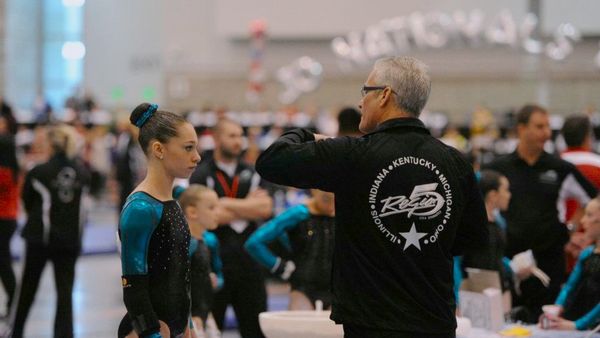Eye For Film >> Movies >> At The Heart Of Gold: Inside The US Gymnastics Scandal (2019) Film Review
At The Heart Of Gold: Inside The US Gymnastics Scandal
Reviewed by: Jennie Kermode

When, on the 12th of September 2016, the Indianapolis Star reported that two former gymnasts had accused Larry Nassar, national medical coordinator for USA Gymnastics, or sexual abuse, the foremost question in the minds of some others was how it had taken so long for his predatory behaviour to come to light. He is now believed to have assaulted at least 250 young people in a pattern of behaviour that might have lasted over two decades. Some of his accusers say that they complained at the time. In this incisive documentary, Erin Lee Carr tries to establish why their voices went unheard.
This isn't a case in which there is any doubt that crimes took place. Nassar has admitted some of what happened and has also been convicted on other counts related to child abuse. Carr doesn't waste time condemning him, assuming that viewers will be quick enough to do so themselves. Instead, she's interested in finding out why some of his victims failed to recognise that they were being abused, why parents didn't take seriously the concerns raised by their children, why other US Gymnastics officials didn't listen when gymnasts and parents did raise complaints, and why - when those complaints eventually did get attention - it took months more for action to be taken that would ensure that other gymnasts were safe.
This isn't just a film about sexual abuse and the culture of stigma and doubt that surrounds it. It's an examination of the wider issues around the vulnerability of children - a vulnerability that isn't simply about their lack of physical power but that pertains to their lower social status. That status is still more precarious in the context of a doctor/patient or coach/student relationship, and several of the victims who tell their stories here explain how they trusted Nassar even when things felt wrong because he was an authority, or how they were hesitant to antagonise him because he had the power to throw them off the Olympic team that was the focus of all their ambitions, the prize to which they had devoted hours of effort every day for years. They also talk about how training hurts - something one as to come to terms with if serious about any sport - and how, as a result, they wee already conditioned to tolerate pain and to put up with unpleasant things that adults told them were necessary, before the abuse started.
To an outsider, it's bizarre to hear about how Nassar performed intimate actions on his victims and managed to pass these off as medical procedures. Carr gives her subjects room to explain how they were used to having other parts of their bodies physically manipulated all the time as part of their training, whilst parents reveal - directly and more obliquely - how they too were operating according to a non-standard pattern of logic, having long ago set aside many ordinary parental concerns in order to let experts do what they thought was best for their children's careers. Some of the saddest stories concern parents who told their children not to worry and to let Nassar carry on with what he was doing because they were mistaken about what it meant.
Also interviewed here is one of the officials who dealt with accusations about Nassar's behaviour. Carr provides additional material to evidence the way that the matter was progressed and set aside through the institution of a series of safeguards which the determined abuser could easily work around. There are important lessons here for other organisations dealing with similar complaints, highlighting what's necessary to make safeguarding effective whilst investigations are being carried out. through he choice of material, Carr also demonstrates how some of the actions intended to protect them actually made the gymnasts more vulnerable, as well as compounding their sense that, by voicing concerns, they had done something wrong.
Although there are likely to be other victims in this case who never felt able to speak up, the picture that emerges here of those who did is also important. These are brave, assertive people - people whose lingering pain is clear, but who don't perpetuate the cliché of the broken victim. They talk about the process of recovery and reclaiming space in their lives in a matter of fact way that will doubtless be helpful to others.
The obsession, single-mindedness and social isolation involved with pursuing sport at the top level were clear contributors to Nassar being able to do what he did, and the more difficult question that emerges here - though it isn't voiced directly - concerns the extent to which they are abusive in themselves. How far is the US - or any country - willing to go for gold? How much do the young people caught up in that process matter? Despite its title, this film depicts a world in which the heart seems altogether absent.
Reviewed on: 29 Dec 2019















